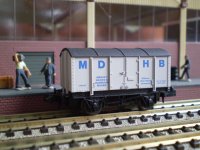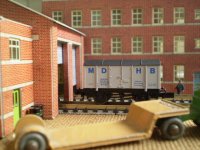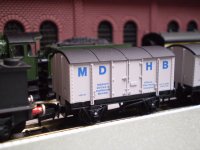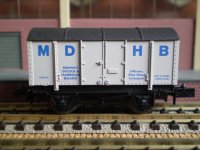The town of Liverpool, on the northern bank of the Mersey estuary, was a major port long before railways
were ever thought of. In 1715 the town council's Dock Committee opened the world's first commercial
wet dock, constructed by enclosing part of a natural tidal pool off the river, and as the eighteenth century
wore on further facilities were added to form a substantial dock network. By the time the Victorian era with all
its new-fangled technology was getting into full swing, Liverpool's dock system had become too extensive
for the council, or Liverpool Corporation as it was by then, to manage efficiently alongside all their other
responsibilities. A new separate organisation was clearly needed to run this vast commercial enterprise in
a proper shipshape manner, and in 1858 the Mersey Docks and Harbour Board was born. Under this new
management the port went from strength to strength, and alongside the docks and the warehouses sprang
up a gleaming new rail network to connect them with the outside world. At its peak the MDHB railway
extended to 104 miles, long enough to connect Liverpool with Birmingham and still have a few miles left over.
It ran throughout the dock systems on both sides of the river, with connections to many other railways, and
even included its own dockside passenger station at Liverpool Riverside. The volume of freight passing
through the port grew ever larger and Liverpool grew ever richer, outgrowing its town status and becoming
a city in 1880.
The railway companies did very nicely out of carrying goods to and from the docks, charging
the merchants and the shipping lines for the privilege of using their railway wagons and vans, and the sharp
management of the Dock Board spotted an opportunity to cut themselves in on the action. If they had their
own fleet of vans then they could cream off some of the business and pocket even more of the proceeds.
Genius! However the commercial corporate world was just as cut-throat then as it is now, and understandably
the railway companies weren't very taken with the idea of losing money by hauling other people's wagons
around instead of their own, so the proposed MDHB wagon fleet never got off the drawing board. But if both
sides had been prepared to come to a deal instead of machoing it out, then vans like ours could have
been loaded up by the side of the Mersey and hauled here there and everywhere across the British rail
network. Steel-bodied vans of this type were first constructed in the First World War era, and virtually
identical vans were still running in the 1970s, so our model would be suitable for any era from pre-grouping
steam through to BR blue diesel.
Indulge a flight of fancy on your layout with our MDHB van.
|









